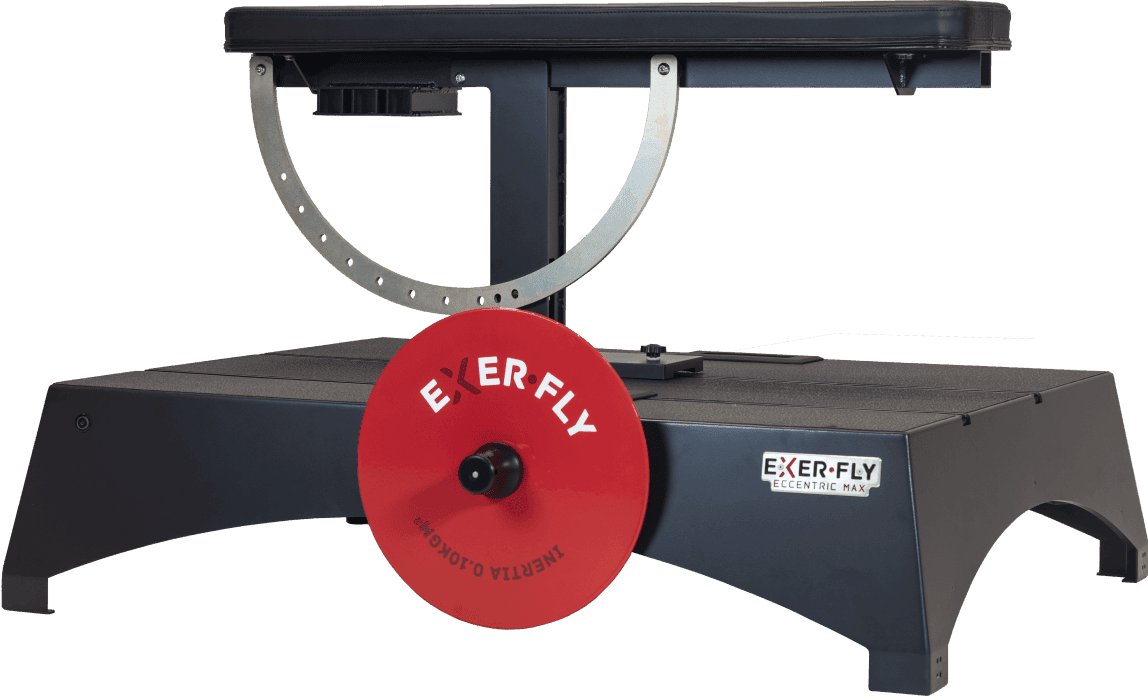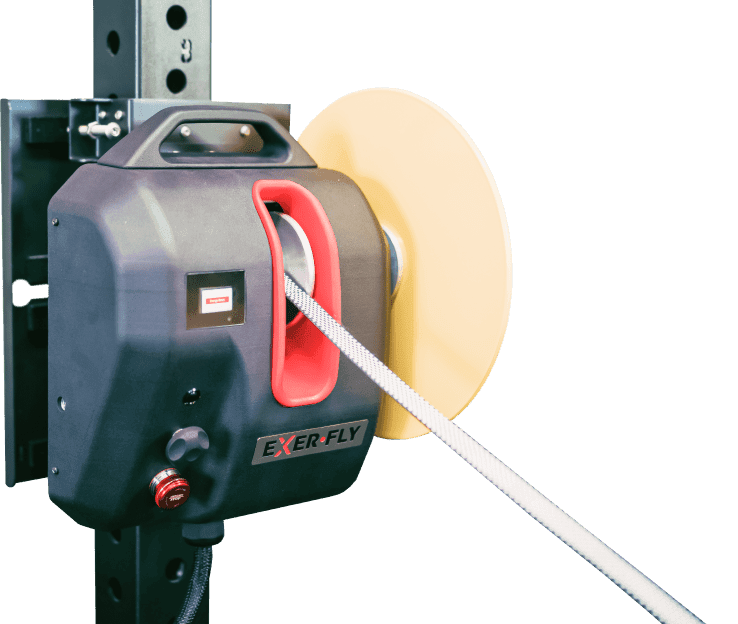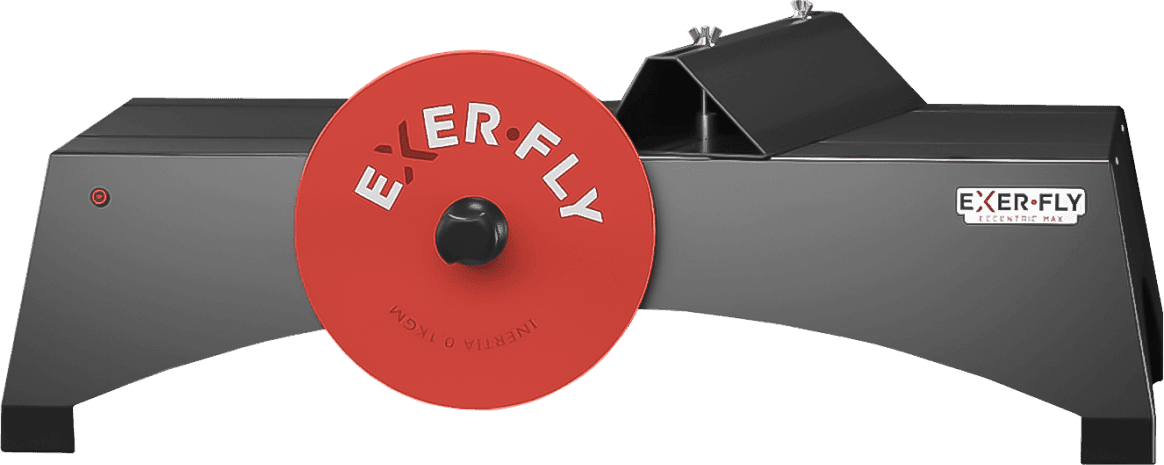
Mastering Flywheel Training: Harnessing the Potential of Inertial Load-Velocity Profiles
Introduction
Limited training load and monitoring guidelines for flywheel training exist. One possible reason for this is that with flywheel technology, determining a true 1RM is not feasible since there is no maximum load that can be lifted. Rather, an athlete needs to accelerate the flywheel during the concentric phase, which then releases the stored energy during the following eccentric phase (3). Where flywheel training does not differ from traditional resistance training is the relationship between load and movement velocity (4). In traditional resistance training, the mean concentric velocity decreases as an athlete approaches their one repetition maximum (1RM), whereas in flywheel training, the mean concentric velocity decreases as the inertial load increases. This quantification of velocities across varying loads for individual athletes can be defined as a load-velocity profile.
Load-velocity profiling has been well researched and adapted into practice in traditional resistance training. However, there has been limited application of this to flywheel training until recently. Martín-Rivera et al. (4) examined the relationship between mean concentric velocity and inertial load in 25 physically active males utilizing a protocol of 5 sets of 6 repetitions of the flywheel squat exercise with different inertial loads (0.047, 0.104, 0.161, 0.245, 0.321 kg m2). Not only did they find a strong correlation between inertial load and velocity, but also found excellent test-retest reliability across 2 sessions separated by 1 week. Spudić et al. (7) similarly reported the high reliability of load velocity-related outcomes using the flywheel squat with loads of .025, .075, .225, .25 kg m2. It seems that inertial load-velocity profiling is a reliable method to quantify load and to individualize the prescription of flywheel training.
Application
Individualizing Programming:
The Inertial load-velocity profile can provide you with a framework and assistance in prescribing an appropriate load when utilizing velocity thresholds or zones. By utilizing individual inertial load-velocity profiles, you can properly map out the inertial load and its corresponding velocities that they wish to achieve during that training session (Figure 1). For instance, maximal strength work has previously been suggested to occur at a zone of < 0.50 m/s (1). If increasing maximal strength is the focus of the training phase or day, it may be most advantageous for Athlete 1 to do the majority of their volume at a load greater than .125 kg m2, whereas for stronger athletes (Athlete 2), this velocity occurs at higher loads (> .175 kg m2). For additional information on the application of velocity zones in flywheel training, tune into my future blog that will discuss this in greater detail.
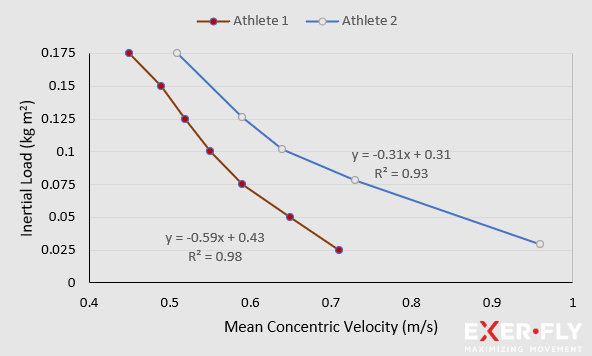
The load velocity profile can also provide you with additional insight into identifying an athlete's force-velocity deficiency (6), which can be identified by the steepness of the slope. A slope that is closer to zero or a flatter line would indicate that the athlete is strength-deficient, whereas a slope that is further away from zero or a more vertical line would indicate that an athlete is velocity-deficient. For instance, Figure 1 depicts two athletes' inertial velocity profiles. The rightward position of the 2nd athlete's profile may indicate that the athlete is stronger in comparison to athlete 1. However, when comparing the slopes of the profiles, Athlete 2 has a slope that is less steep, indicating that Athlete 2 may be more velocity-dependent. Jiménez Reyes et al. (2) divided 84 subjects into velocity-deficient, force-deficient, well-balanced, and non-optimized groups based on their force-velocity profiles. Following a 9-week intervention that targeted their specific deficiencies, they found that both the force-deficient group, velocity-deficient, and well-balance training group increased their vertical jump performance, while the non-optimized group results were highly variable and unclear. This suggests that programs can be tailored to an individual based on their force-velocity profile or potentially its counterpart of inertial load-velocity. It should be noted that the force-velocity imbalance equation (6) was derived from assessments that utilized weighted vertical jumps, and such equations have not yet been established for flywheel training. Alternatively, comparisons can be made to normative values collected among the cohort that you primarily work with.
Assessing changes
The Inertial load-velocity profile can be utilized by you to assess changes in strength-related variables within an athlete following a training phase. For instance, following an 8-week training phase that focuses on equally improving all aspects of the strength continuum (i.e., strength, power, and speed), will likely result in improving their movement in velocity across each load, which would result in a rightward shift of the graph (Figure 2). It would behoove you to follow a similar before and after inertial load-velocity profile assessment to accurately assess these changes following a training intervention. You can accomplish this by conducting the assessments using the same inertial loads as well as following the same set and repetition protocol.

It is also possible for you to quantify improvements to specific areas along the line. The information derived from this can not only assist you in profiling your athletes but also provide insight into the effectiveness of a training phase. For example, following a phase that is primarily focused on strength, a well-trained athlete may see larger improvements in the velocities at heavier loads resulting in a steeper slope, whereas a phase primarily focused on speed, the majority of the improvements in velocity are likely seen at lighter loads resulting in a flatter slope (2) (Figure 3). It is important to note that some additional factors such as training age, the level of experience with flywheel training, and strength levels may influence the response your athlete may have when introducing flywheel training (5).
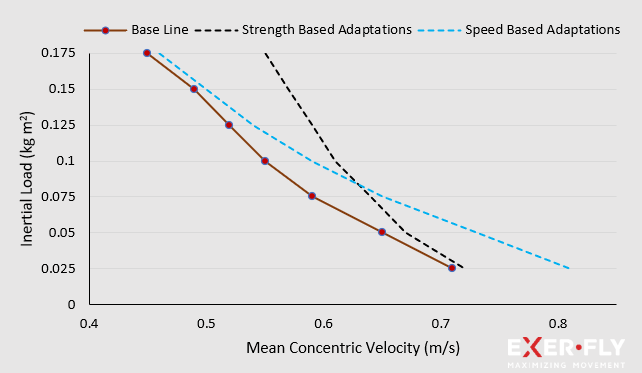
Assessing Athletes
Building out an inertial load-velocity profile is a simple assessment and can be a great tool when implementing flywheel training. Figure 1, Athlete A depicts a recent 7 set assessment that I conducted with an athlete, in which we use 7 different Inertial loads ranging from .025 to .175 kg m2, with increments of .025 kg m2, in a randomized order. A rep scheme consisting of 2 warm-up reps and 6 – 7 working reps, with each set separated by at least 2 minutes of rest was utilized. As shown above this athlete displayed a near perfect relationship between inertial load and mean concentric velocity (R2 = .98). Conducting assessments with a wide range of loads may provide you with a fuller picture; however, I recommend only utilizing 4 – 5 different Inertial loads in a team-based setting to increase time efficiency (Athlete 2, Figure 1). In addition, I suggest assessing 2 – 3 athletes at a time if the number of Exerfly units is limited to take advantage of the required rest periods associated with the assessment. Mean concentric velocity and other kinematic variables are easily monitored on our flywheel devices by the built-in sensor (rotary encoder) (7), and each set can be exported from the Exerfly app for further analysis.
Conclusion
Inertial load-velocity profile is an assessment that compares the mean concentric velocity across 4 – 7 different inertial loads. You can monitor and export each set by means of the Exerfly app to build out individual Inertial load-velocity profiles. Profiles can provide a framework and assistance in prescribing an appropriate load. In addition, it can be utilized to assess changes in strength-related variables and may be able to provide insight into the effectiveness of a training phase.
-
González-Badillo, JJ and Sánchez-Medina, L. Mmovement velocity as a measure of loading intensity in resistance training. Int J Sports Med 31: 347–352, 2010.
-
Jiménez-Reyes, P, Samozino, P, Brughelli, M, and Morin, J-B. Effectiveness of an individualized training based on force-velocity profiling during jumping. Front Physiol 7, 2017.Available from: http://journal.frontiersin.org/article/10.3389/fphys.2016.00677/full
-
Maroto-Izquierdo, S, Raya-González, J, Hernández-Davó, JL, and Beato, M. Load quantification and testing using flywheel devices in sports. Front Physiol 12: 739399, 2021.
-
Martín-Rivera, F, Beato, M, Alepuz-Moner, V, and Maroto-Izquierdo, S. Use of concentric linear velocity to monitor flywheel exercise load. Front Physiol 13: 961572, 2022.
-
Petré, H, Wernstål, F, and Mattsson, CM. Effects of flywheel training on strength-related variables: a meta-analysis. Sports Med - Open 4: 55, 2018.
-
Samozino, P, Edouard, P, Sangnier, S, Brughelli, M, Gimenez, P, and Morin, J-B. Force-velocity profile: imbalance determination and effect on lower limb ballistic performance. Int J Sports Med 35: 505–510, 2013.
-
Spudić, D, Cvitkovič, R, and Šarabon, N. Assessment and evaluation of force–velocity variables in flywheel squats: validity and reliability of force plates, a linear encoder sensor, and a rotary encoder sensor. Applied Sciences 11: 10541, 2021.

